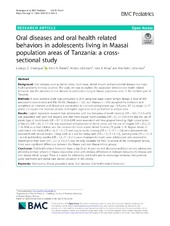Oral diseases and oral Health related behaviors in adolescents living in Maasai population areas in Tanzania: a cross sectional study
Simangwa, Lutango; Åstrøm, Anne Nordrehaug; Johansson, Anders; Minja, Irene K.; Johansson, Ann Katrin
Peer reviewed, Journal article
Published version

Åpne
Permanent lenke
https://hdl.handle.net/1956/23590Utgivelsesdato
2019Metadata
Vis full innførselSamlinger
Originalversjon
https://doi.org/10.1186/s12887-019-1655-8Sammendrag
Background: Oral diseases, such as dental caries, tooth wear, dental erosion and periodontal diseases are major health problems in many societies. The study aim was to explore the association between oral health related behaviors and the presence of oral diseases in adolescents living in Maasai population areas in the northern part of Tanzania. Methods: A cross sectional study was conducted in 2016 using one stage cluster sample design. A total of 989 adolescents were invited and 906 (91.6%; (Maasais n = 721, non Maasais n = 185) accepted the invitation and completed an interview and clinical oral examination in a school setting (mean age 13.4 years, SD 1.2, range 12–17 years). Chi-square test, bivariate analysis and logistic regression were performed to analyze data. Results: Logistic regression revealed that: adolescents with low frequency of tooth cleaning (OR = 10.0, CI 4.3–20.0) was associated with poor oral hygiene and that more regular tooth cleaning (OR = 0.1, CI 0.04–0.14) and the use of plastic type of tooth brush (OR = 0.7, CI 0.53–0.99) were associated with less gingival bleeding. High consumption of biscuits (OR = 2.5, CI 1.7–3.8) was associated with presence of dental caries and the use of magadi (OR = 24.2, CI 11.6–50.6) as a food additive was the covariate for more severe dental fluorosis (TF grade 5–9). Regular intake of carbonated soft drinks (OR = 1.6, CI 1.1–2.5) and regular tooth cleaning (OR = 1.7, CI 1.1–2.6) were independently associated with dental erosion. Using teeth as a tool for: biting nails (OR = 1.9, CI 1.4–2.4), opening soda (OR = 1.8, CI 1.4–2.4) and holding needles (OR = 1.6, CI 1.3–2.1) were covariates for tooth wear. Adolescents who reported to clench/grind their teeth (OR = 2.3, CI 1.5–3.7) was the only covariate for TMD. In several of the investigated factors, there were significant differences between the Maasai and non Maasai ethnic groups. Conclusion: Oral health related behaviors have a significant impact on oral diseases/conditions among adolescents attending primary schools in Maasai population areas with obvious differences in behavior between the Maasai and non Maasai ethnic groups. There is a need for addressing oral health and to encourage behaviors that promote good oral health and dental care service utilization in this society.
